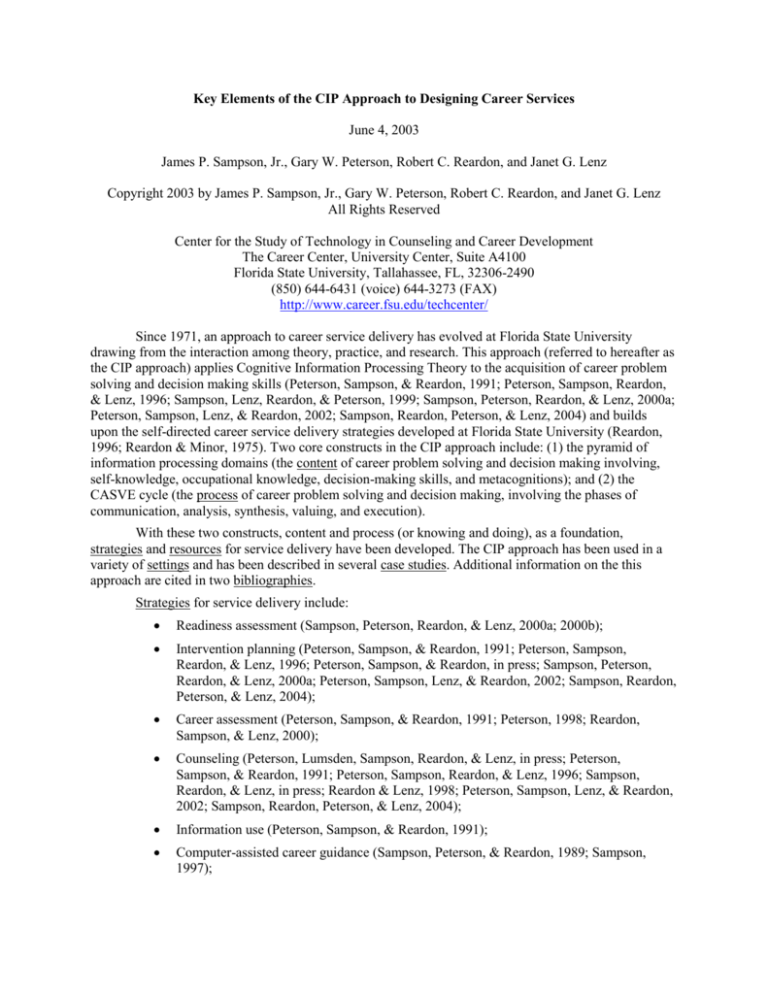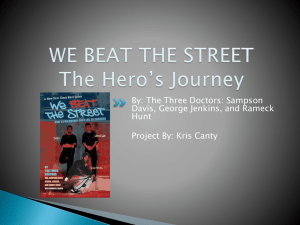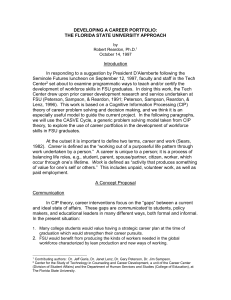
Key Elements of the CIP Approach to Designing Career Services
June 4, 2003
James P. Sampson, Jr., Gary W. Peterson, Robert C. Reardon, and Janet G. Lenz
Copyright 2003 by James P. Sampson, Jr., Gary W. Peterson, Robert C. Reardon, and Janet G. Lenz
All Rights Reserved
Center for the Study of Technology in Counseling and Career Development
The Career Center, University Center, Suite A4100
Florida State University, Tallahassee, FL, 32306-2490
(850) 644-6431 (voice) 644-3273 (FAX)
http://www.career.fsu.edu/techcenter/
Since 1971, an approach to career service delivery has evolved at Florida State University
drawing from the interaction among theory, practice, and research. This approach (referred to hereafter as
the CIP approach) applies Cognitive Information Processing Theory to the acquisition of career problem
solving and decision making skills (Peterson, Sampson, & Reardon, 1991; Peterson, Sampson, Reardon,
& Lenz, 1996; Sampson, Lenz, Reardon, & Peterson, 1999; Sampson, Peterson, Reardon, & Lenz, 2000a;
Peterson, Sampson, Lenz, & Reardon, 2002; Sampson, Reardon, Peterson, & Lenz, 2004) and builds
upon the self-directed career service delivery strategies developed at Florida State University (Reardon,
1996; Reardon & Minor, 1975). Two core constructs in the CIP approach include: (1) the pyramid of
information processing domains (the content of career problem solving and decision making involving,
self-knowledge, occupational knowledge, decision-making skills, and metacognitions); and (2) the
CASVE cycle (the process of career problem solving and decision making, involving the phases of
communication, analysis, synthesis, valuing, and execution).
With these two constructs, content and process (or knowing and doing), as a foundation,
strategies and resources for service delivery have been developed. The CIP approach has been used in a
variety of settings and has been described in several case studies. Additional information on the this
approach are cited in two bibliographies.
Strategies for service delivery include:
Readiness assessment (Sampson, Peterson, Reardon, & Lenz, 2000a; 2000b);
Intervention planning (Peterson, Sampson, & Reardon, 1991; Peterson, Sampson,
Reardon, & Lenz, 1996; Peterson, Sampson, & Reardon, in press; Sampson, Peterson,
Reardon, & Lenz, 2000a; Peterson, Sampson, Lenz, & Reardon, 2002; Sampson, Reardon,
Peterson, & Lenz, 2004);
Career assessment (Peterson, Sampson, & Reardon, 1991; Peterson, 1998; Reardon,
Sampson, & Lenz, 2000);
Counseling (Peterson, Lumsden, Sampson, Reardon, & Lenz, in press; Peterson,
Sampson, & Reardon, 1991; Peterson, Sampson, Reardon, & Lenz, 1996; Sampson,
Reardon, & Lenz, in press; Reardon & Lenz, 1998; Peterson, Sampson, Lenz, & Reardon,
2002; Sampson, Reardon, Peterson, & Lenz, 2004);
Information use (Peterson, Sampson, & Reardon, 1991);
Computer-assisted career guidance (Sampson, Peterson, & Reardon, 1989; Sampson,
1997);
Key Elements of CIP 2
Employment problem solving and decision making (Sampson, Lenz, Reardon, & Peterson,
1999);
Career resource room design (Peterson, Sampson, & Reardon, 1991; Sampson, 1999);
Staff training (Lenz, 2000; Saunders, Reardon, & Lenz, 1999);
Program development and evaluation (Lenz, Reardon, Peterson, & Sampson, in press;
Peterson, Sampson, Lenz, & Reardon, 1999; Peterson, Sampson, & Reardon, 1991;
Vernick, Garis, & Reardon, 2000); and
International collaboration in theory application (Sampson, Watts, Palmer, & Hughes,
2000).
Resources to apply CIP theory to practice have included:
A readiness assessment instrument – the Career Thoughts Inventory (CTI; Sampson,
Peterson, Lenz, Reardon, & Saunders, 1996a; 1998);
A workbook for cognitive restructuring of negative career thoughts (CTI Workbook;
Sampson, Peterson, Lenz, Reardon, & Saunders, 1996b);
A career assessment card sort (Peterson, 1998);
Instruction for credit courses (Reardon, Lenz, Sampson, & Peterson, 2000a; 2000b); and
Counseling handouts and exercises (Sampson, Peterson, Lenz, & Reardon, 1992).
Settings where the CIP approach has been applied include:
Higher education (Reardon & Wright, 1999);
Community services (Lenz, 1998);
One-stop career centers (Sampson & Reardon, 1998);
Secondary schools (Peterson, Sampson, & Reardon, 1991);
Correctional institutions (Railey & Peterson, 2000); and
Adults (Peterson, Lumsden, Sampson, Reardon, & Lenz, 2002; Peterson, Sampson, Lenz,
& Reardon, 2002).
Case studies are available that describe how the CIP approach is used in practice (Peterson,
Sampson, & Reardon, 1991; Peterson, Sampson, Reardon, & Lenz, 1996; Sampson, Peterson, Lenz,
Reardon, & Saunders, 1996c; Reardon & Wright, 1999; Watson & Lenz, in press).
Bibliographies providing citations of research and evaluation on the CIP approach may be found
in Reardon (1998) and Sampson, Peterson, Reardon, and Lenz (2003).
Using the above literature as a foundation, seven key elements of the CIP approach can be identified
that are essential to the successful application of this approach in practice. These key elements of the CIP
approach to designing careers services are as follows:
Screen individuals for career decision making readiness before delivering services
Match levels of staff assistance to identified individual needs
Use career theory to help individuals understand and manage career decision making
Use the career resource room and Internet web site with all levels of service delivery
Use career resources that are appropriate for diverse individual learners
Use staff teamwork in delivering services to individuals
Provide common staff training for delivering resources and services
Key Elements of CIP 3
Details of each of these key elements are described below.
Key Elements of the Cognitive Information Processing Approach
Key elements of the CIP approach are based on the assumptions that multiple staff members are
involved in service delivery, a variety of career resources and services are available, and career resources
and services are delivered both in a career center and on an Internet web site. Services with one or two
staff members, services with limited career resources, and services without Internet web sites would need
to adapt the application of the CIP approach to their setting. The organizational affiliation of the career
service, the qualifications of staff, and the nature of individuals served may require further adaptation of
the CIP approach in order to effectively integrate this approach with existing career services.
1. Screen Individuals for Career Decision Making Readiness Before Delivering Services
Individuals vary in their readiness for making career decisions (Phillips & Blustein, 1994).
Numerous theoretical constructs have evolved to explain why some individuals have difficulty in career
decision making such as, vocational maturity (Super, 1974), career maturity (Crites, 1996), career
adaptability (Super, 1983; Savickas, 1994), vocational identity (Holland, 1997), decision-making selfefficacy (Lent & Hackett, 1987), career beliefs (Krumboltz, 1983), and dysfunctional career thinking
(Sampson et al., 1998; Peterson, et al., 2002). If individuals are not screened prior to receiving career
services, those individuals with low readiness for decision making may be underserved by staff who are
unaware of their substantial need for assistance, while high readiness individuals may be overserved by
staff who deliver expensive individualized interventions when less expensive approaches would likely be
equally effective (Sampson, et al., 2000a).
In the CIP approach, screening individuals at the outset of service delivery increases the
likelihood that the services delivered are congruent with individual needs. As a result of better allocation
of scarce staff resources, staff will have time to serve more individuals with briefer interventions or will
have more time to deliver intensive individualized interventions to assist individuals with extensive
needs. The screening process may be as simple as asking individuals to articulate their reasons for seeking
assistance and judging readiness based on their response. If this brief screening question indicates a
concrete request for information exists and that no potential problems exist, then no further screening is
needed at that time and a referral is made to self-help resources. If this brief screening question indicates
that no concrete request for information exists and that potential problems exist (such as uncertainty when
a decision needs to be made, confusion, or disabling emotions), then more comprehensive screening is
likely needed. A readiness assessment measure, such as the Career Thoughts Inventory (Sampson et al.,
1996a) may be used to assist staff in making a judgment about individuals’ readiness for career decision
making (Sampson, et al. 2000a, 2004; Peterson, et al. 2002). The use of a comprehensive screening
measure provides individuals and practitioners with an easily understood, common frame of reference for
discussing readiness. It is important to emphasize that staff members’ judgments about individuals’
readiness for career decision making should be based on test results and interaction with the individual, as
opposed to a relying on a simple score on an assessment instrument. The goal of readiness assessment is
to help both individuals and practitioners make informed, collaborative decisions about the level of staff
assistance that is most likely to meet their needs.
2. Match Levels of Staff Assistance to Identified Individual Needs
Given that one of the goals of the CIP approach is to avoid overserving and underserving
individuals, the screening process described above is used in selecting an appropriate level of staff
assistance in relation to individuals’ need for assistance. Three levels of service delivery are included in
the CIP approach: (1) self-help services, (2) brief staff-assisted services, and (3) individual case-managed
services (Sampson et al., 2000a, 2004; Peterson et al., 2002).
Key Elements of CIP 4
Individuals who are initially judged by staff to have a high level of readiness for decision making
are referred to self-help career services. In the CIP approach, career resource rooms and Internet web sites
are designed to assist individuals in selecting, locating, sequencing, and using needed resources with little
or no assistance from staff.
Individuals who are initially judged by staff to have a moderate level of readiness for decision
making are referred to brief staff-assisted services. This includes self-directed career decision making,
involving practitioner-guided use of career resources and services in a career resource room by
individuals with adequate decision-making readiness to effectively learn in this environment. Staff
teamwork and the continuity offered by the use of an individual learning plan (ILP), allows individuals to
work with one or more staff members of their choosing and to decide how quickly they will proceed. An
ILP helps clients and practitioners to collaboratively plan the use of resources and services necessary to
solve a career problem. The written individual plan includes client goals and prioritized learning activities
with related outcomes. Other brief staff-assisted services include shorter-term group counseling (less than
6 sessions), career courses with large-group interaction, and workshops. In each of these group
interventions, the opportunity for interaction among participants is minimal to moderate.
Individuals who are initially judged by staff to have a low level of readiness for decision making
are ideally referred to individual case-managed services. This includes individual counseling, longer-term
group counseling (more than 6 sessions), and career courses with small group interaction. By having a
greater amount of time available for service delivery, staff can proceed at a pace slow enough for lowreadiness individuals to process information more effectively and to deal with a diverse range of issues
that make decision making difficult. Group interventions in this category allow maximum opportunity for
interaction among participants.
The resulting net effect of the CIP approach is to limit expensive services (in terms of staff
resources) to individuals with more extensive needs. The effectiveness of this approach is dependent on
staff briefly checking with individuals receiving self-help and brief interventions to ensure that their needs
are being met and increasing the level of staff assistance when it becomes apparent that additional
assistance is needed (Sampson et al., 2000a, 2004; Peterson, et al., 2002).
The CIP approach also assumes that practitioners may have diverse training and qualifications.
The use of a team approach (with paraprofessionals, professionals-in-training, and professionals working
collaboratively) has been shown to contribute to the cost-effectiveness of career service delivery
(Reardon, 1996). Practitioners delivering services to low readiness individuals need specific training in
individual case-managed interventions that may include the integration of career and mental health issues.
3. Use Career Theory to Help Individuals Understand and Manage Career Decision Making
Career theory serves two purposes in the CIP approach. First, career theory helps the practitioner
decide how much and what type of assistance individuals will need in order to solve career problems and
make career decisions. Second, career theory helps individuals understand the content of career decision
making (What individuals need to know) and the process of career decision making (What individuals
need to do). This understanding can help individuals create a cognitive framework or schema for career
choice that reduces ambiguity in the career choice process, better manage the overwhelming amount of
career choice information that is available, and provides clear criteria for self-monitoring of progress in
decision making.
In order for individuals to use theory to better understand and manage career decision making,
theoretical constructs need to be translated into terminology that individuals can readily comprehend.
Several strategies have been used in the CIP approach to translate theoretical constructs for use by
individuals using resources and receiving services. The language of the original constructs developed by
Key Elements of CIP 5
Peterson et al., (1991) was translated by Sampson, Peterson, Lenz, and Reardon (1992) to avoid
professional jargon and improve clarity. These revised constructs are presented to individuals on handouts
as part of self-help services, brief staff-assisted services, and individual case managed services to help
individuals understand and manage career decision making. These translated concepts, supported by
several metaphors, are also used in an instructional workbook designed to restructure negative cognition
and enhance competence in career decision making (Sampson et al., 1996b).
4. Use the Career Resource Room and Internet Web Site with All Levels of Service Delivery
In the CIP approach, career resource rooms and Internet web sites play a key role in the delivery
of resources and services. As mentioned previously, career resource rooms and web sites provide
individuals with self-help access to resources that meet identified learning needs. The career resource
room is an open space within the career center having a reception area, bookshelves and files for
maintaining resources, tables and computer work stations for the use of resources, and adjacent group
rooms and staff offices. The Internet web site is the distance guidance component of the career service
(Sampson, 1999). The effectiveness of self-help services delivered in career resource rooms is dependent
on having:
(a) an easy to understand classification schema for organizing resources;
(b) an index to identify available resources;
(c) resource guides to help individuals select resources that meet their needs;
(d) clear signage to physically locate resources; and
(e) a comfortable and attractive place to use resources and receive services (Peterson et al., 1991).
The effectiveness of self-help services delivered via Internet web sites is dependent on having:
(a) the site designed to help users select appropriate resources by linking individuals’ needs to
resources and external links;
(b) suggestions provided on how to sequence and use the resources and links that are available;
(c) assessment, information, and instruction that has been validated for self-help use; and
(d) a description of the circumstances when help from a practitioner is typically needed to meet
needs (Sampson, 1999).
The career resource room can also be effectively used in brief staff-assisted services by having staff assist
individuals select, locate, sequence, and use resources based on the creation and regular review of ILPs.
Similarly, the career resource room can be effectively used in individual case-managed services
by bringing clients into the resource room during a session to use resources under the supervision of the
practitioner. In this way, learning can be enhanced by taking advantage of the "teachable moment" to
immediately clarify and apply what has been learned, or to identify dysfunctional thoughts that inhibit
learning and decision making, without having to wait for the next scheduled appointment with a
practitioner.
The Internet web site can also be used in the career resource room or staff offices as part of brief
staff-assisted or individual case-managed services to model and reinforce information-seeking behavior.
Low readiness clients who have difficulty processing information may still be effective Internet web site
users if appropriate assistance is provided by a practitioner in the use of the web site.
Key Elements of CIP 6
5. Use Career Resources that are Appropriate for Diverse Individual Learners
The CIP approach recognizes that individuals vary in terms of their verbal aptitude, motivation,
and learning style (Peterson et al., 1991, 2002; Sampson, et al., 2004). Ideally, the career resources
available in the career resource room and on the Internet web site should be appropriate for the inherent
diversity in individuals’ verbal aptitude, motivation, and learning style. In terms of verbal aptitude, it is
particularly important for resources to be available in a range of readability. Many career resources are
written at secondary school or college reading level, which may lead to failed interventions for
adolescents and adults with limited reading ability.
Advertising that a wide range of individuals can be served in a career service, when in fact only
highly verbal individuals can successfully use the resources available, may result in failure experiences
for individuals with limited reading skills and make them reluctant to seek further career assistance. In
terms of motivation and learning style, traditional text-based resources (which may include simple textbased Internet web sites) need to be supplemented with video and interactive computer-based resources
that may be more reinforcing for some learners (Peterson et al., 1991, Sampson, et al., 2004). Care also
needs to be taken that individuals’ physical disabilities do not prevent them from accessing resources in
career resource rooms. Similarly, Internet web sites should be accessible through text readers for persons
with visual disabilities.
6. Use Staff Teamwork in Delivering Services to Individuals
An essential brief staff-assisted service in the CIP approach described previously is self-directed
career decision making. As stated previously, this intervention involves practitioner-guided use of career
resources and services in a career resource room by individuals with adequate decision-making readiness
to effectively learn in this environment. The assumption is that continuity in service delivery resides in
the collaboratively developed written ILP, as opposed to the behavior of any single staff member. This
results in two benefits to the individual. First, the individual is not restricted to the available appointment
times of any one practitioner. Second, individuals are also able to decide how quickly they will use
available resources and services. Individuals can choose to spend considerable time working on their
career problem with several staff members or they can choose to work with one staff member during his
or her assigned times in the career resource room if they value the relationship with one particular
practitioner (Sampson & Reardon, 1998). For this approach to be effective, however, staff teamwork is
essential. Staff members must be able to quickly establish helping relationships, clarify client progress in
completing the ILP, and subsequently revise the ILP if new needs emerge.
7. Provide Common Staff Training for Delivering Resources and Services
Another factor in the success of the self-directed career decision-making intervention described
above is common staff training (Sampson & Reardon, 1998). Common training experiences among staff
are needed to reduce the likelihood of inconsistent or disjointed service delivery when multiple staff serve
one individual. Individuals may become confused and discouraged if some staff are unable to help them
effectively use the resources and services included on their ILP.
There is a content and process dimension to common staff training. In terms of the content
dimension, all staff need to be familiar with the theoretical basis of service delivery in order to assist
clients in understanding and managing the career decision-making process. All staff also need to be
competent in the use of core assessment, information, and instructional resources. In terms of the process
dimension, all staff need to be competent in the readiness assessment and intervention planning elements
of the CIP approach. This includes competence in the use of one or two common readiness assessment
instruments, as well as the use of readiness assessment data in selecting an appropriate type and amount
of staff intervention and in collaboratively designing an ILP to adequately meet client needs.
Key Elements of CIP 7
In terms of staff training, career resources can be categorized as core or specialized resources.
Core career resources and services are those judged to be relevant to common career problems with all
staff expected to be competent in their use or delivery. Specialized career resources and services are those
judged to be relevant to less common career problems with specific staff having expertise in assisting
individuals or other staff in their use or delivery.
Conclusion
This paper has highlighted seven key elements of the cognitive information processing approach
to career problem solving and decision making. By concentrating on the essential elements of the CIP
approach, it is hoped that practitioners will be more successful in translating theory into practice,
ultimately contributing to improved career problem solving and decision making among individuals
seeking career resources and services.
References
Crites, J. O. (1996). CMI sourcebook. Ottawa, Ontario: Careerware: ISM Corporation.
Holland, J. L. (1997). Making vocational choices: A theory of vocational personalities and work
environments (3rd ed.). Odessa, FL: Psychological Assessment Resources.
Krumboltz, J. D. (1983). Private rules in career decision making (Special Publications Series No. 38).
Columbus, OH: Ohio State University, National Center for Research in Vocational Education,
Advanced Study Center. (ERIC Document Reproduction Service No. ED 229 608)
Lent, R. W., & Hackett, G. (1987). Career self-efficacy: Empirical status and future directions
[Monograph]. Journal of Vocational Behavior, 30, 347-382.
Lenz, J. G. (1998). A career center’s community connection. Australian Journal of Career Development,
7, 3-4.
Lenz, J. G. (2000). Paraprofessionals in career services: The Florida State University model (technical
report No. 27). Tallahassee, FL: Florida State University, Center for the Study of Technology in
Counseling and Career Development
Lenz, J. G., Reardon, R. C., Peterson, G. W., & Sampson, J. P., Jr. (in press). Applying cognitive
information processing (CIP) theory to career program design and development. In Patton, W., &
McMahon, M. (Eds.). Career development programs: Preparation for lifelong career decisionmaking. Camberwell, VIC: ACER Press.
Peterson, G. W. (1998). Using a vocational card sort as an assessment of occupational knowledge.
Journal of Career Assessment, 6, 49-67.
Peterson, G. W., Lumsden, J. A., Sampson, J. P., Jr., Reardon, R. C., & Lenz, J. G. (2002). Using
cognitive information processing in counseling with adults. In S. Niles (Ed.), Adult career
development (3rd ed., pp. 98-117). Tulsa, OK: National Career Development Association.
Peterson, G. W., Sampson, J. P., Jr., Lenz, J. G., & Reardon, R. C. (1999, May). Three contexts of career
problem solving and decision making. Paper presented at the annual meeting of the Society for
Vocational Psychology entitled, “Examining the interaction of person in environment: Role of
context factors in vocational development,” Milwaukee, WI.
Peterson, G. W., Sampson, J. P., Jr., & Reardon, R. C. (1991). Career development and services: A
cognitive approach. Pacific Grove, CA: Brooks/Cole.
Key Elements of CIP 8
Peterson, G. W., Sampson, J. P., Jr., Reardon, R. C., & Lenz, J. G. (1996). Becoming career problem
solvers and decision makers: A cognitive information processing approach. In D. Brown & L.
Brooks (Eds.), Career choice and development (3rd ed., pp. 423-475). San Francisco, CA:
Jossey-Bass.
Peterson, G. W., Sampson, J. P., Jr., Lenz, J. G., & Reardon, R. C. (2002). Becoming career problem
solvers and decision makers: A cognitive information processing approach. In D. Brown (Ed.),
Career choice and development (4th ed., pp. 312-369). San Francisco, CA: Jossey-Bass.
Phillips, S. D., & Blustein, D. L. (1994). Readiness for career choices: Planning, exploring, and deciding.
The Career Development Quarterly, 43, 63-67.
Railey, M. G. and Peterson, G. W. (2000). The assessment of dysfunctional career thoughts and interest
structure among female inmates and probationers. Journal of Career Assessment, 8(2), 119-129.
Reardon, R. C. (1996). A program and cost analysis of a self-directed career decision-making program in
a university career center. Journal of Counseling and Development, 74, 280-285.
Reardon, R. C. (1998). Bibliographic references: Curricular-career information service. Tallahassee, FL:
Florida State University, The Career Center.
Reardon, R., & Lenz, J. (1998). The Self-Directed Search and related Holland career materials: A
practitioner’s guide. Odessa, FL: Psychological Assessment Resources, Inc.
Reardon, R. C., & Minor, C. (1975). Revitalizing the career information service. Personnel and Guidance
Journal, 54, 169-171.
Reardon, R. C., Lenz, J. G., Sampson, J. P., Jr., & Peterson, G. W. (2000a). Career development and
planning: A comprehensive approach. Pacific Grove, CA: Brooks/Cole.
Reardon, R. C., Lenz, J. G., Sampson, J. P., Jr., & Peterson, G. W. (2000b). Student handbook for career
development and planning: A comprehensive approach. Pacific Grove, CA: Brooks/Cole.
Reardon, R. C., Sampson, J. P., Jr., & Lenz, J. G. (2000). Career assessment in a time of changing roles,
relationships, and contexts. Journal of Career Assessment, 8, 351-359.
Reardon, R. C., & Wright, L. K. (1999). The case of Mandy: Applying Holland’s theory and cognitive
information processing theory. The Career Development Quarterly, 47, 195-203.
Sampson, J. P., Jr. (1997, April). Helping clients get the most from computer-assisted career guidance
systems. Paper presented at the Australian Association of Career Counselors 7th
National/International Conference, Brisbane, Australia.
Sampson, J. P., Jr. (1999). Integrating Internet-based distance guidance with services provided in career
centers. The Career Development Quarterly, 47, 243-254.
Sampson, J. P., Jr. (1999). Elements of an effective career resource room. Retrieved from Florida State
University, Center for the Study of Technology in Counseling and Career Development Web site
http://www.career.fsu.edu/techcenter/designing_career_services/practical_strategies/index.html
Sampson, J. P., Jr., Lenz, J. G., Reardon, R. C., & Peterson, G. W. (1999). A cognitive information
processing approach to employment problem solving and decision making. The Career
Development Quarterly, 48, 3-18.
Key Elements of CIP 9
Sampson, J. P., Jr., Peterson, G. W., Lenz, J. G., & Reardon, R. C. (1992). A cognitive approach to career
services: Translating concepts into practice. Career Development Quarterly, 41, 67-74.
Sampson, J. P., Jr., Peterson, G. W., Lenz, J. G., Reardon, R. C., & Saunders, D. E. (1996a). Career
Thoughts Inventory. Odessa, FL: Psychological Assessment Resources, Inc.
Sampson, J. P., Jr., Peterson, G. W., Lenz, J. G., Reardon, R. C., & Saunders, D. E. (1996b). Career
Thoughts Inventory workbook. Odessa, FL: Psychological Assessment Resources, Inc.
Sampson, J. P., Jr., Peterson, G. W., Lenz, J. G., Reardon, R. C., & Saunders, D. E. (1996c). Career
Thoughts Inventory: Professional manual. Odessa, FL: Psychological Assessment Resources, Inc.
Sampson, J. P., Jr., Peterson, G. W., Lenz, J. G., Reardon, R. C., & Saunders, D. E. (1998). The design
and use of a measure of dysfunctional career thoughts among adults, college students, and high
school students: The Career Thoughts Inventory. Journal of Career Assessment, 6, 115-134.
Sampson, J. P., Jr., Peterson, G. W., & Reardon, R. C. (1989). Counselor intervention strategies for
computer-assisted career guidance: An information processing approach. Journal of Career
Development, 16, 139-154.
Sampson, J. P., Jr., Peterson, G. W., Reardon, R. C., & Lenz, J. G. (2003). Bibliography: A cognitive
information processing approach to career development and services. Retrieved from Florida
State University, Center for the Study of Technology in Counseling and Career Development.
Web site http://www.career.fsu.edu/techcenter/designing_career_services/cip_bibliographies/index.html
Sampson, J. P., Jr., Peterson, G. W., Reardon, R. C., & Lenz, J. G. (2000a). Using readiness assessment to
improve career services: A cognitive information processing approach. The Career Development
Quarterly, 49, 146-174.
Sampson, J. P., Jr., Peterson, G. W., Reardon, R. C., & Lenz, J. G. (2000b). The viability of readiness
assessment in contributing to improved career services: A response to Jepsen (2000). The Career
Development Quarterly, 49, 179-185.
Sampson, J. P., Jr., & Reardon, R. C. (1998). Maximizing staff resources in meeting the needs of job
seekers in one-stop centers. Journal of Employment Counseling, 35, 50-68.
Sampson, J. P., Jr., Reardon, R. C., Peterson, G. W., & Lenz, J. G. (2004). Career counseling
and services: A cognitive information processing approach. Pacific Grove, CA:
Brooks/Cole.
Sampson, J. P., Jr., Watts, A. G., Palmer, M., & Hughes, D. (2000). International collaboration in
translating career theory to practice. The Career Development Quarterly, 48, 332-339. Also in
(2000) Journal of Employment Counseling, 37(2).
Saunders, D. E., Reardon, R. C., & Lenz, J. G. (1999). Specialty training for career counselors: 25 years
at Florida State University. Career Planning and Adult Development Journal, 15(2), 23-33.
Savickas, M. L. (1994). Measuring career development: Current status and future directions. The Career
Development Quarterly, 43, 54-62.
Super, D. E. (1974). Measuring vocational maturity for counseling and evaluation. Washington, D.C.:
National Vocational Guidance Association.
Key Elements of CIP 10
Super, D. E. (1983). Assessment in career guidance: Toward truly developmental counseling. The
Personnel and Guidance Journal, 61, 555-562.
Vernick, S. H., Garis, J., & Reardon, R. C. (2000). Integrating service, teaching, and research in a
comprehensive university career center. Career Planning and Adult Development Journal, 16(1),
7-24.
Watson, J., & Lenz, J. G. (in press). The case of Raven. In S. G. Niles, J. Goodman, & M. Pope, (Eds.),
The Career counseling casebook: A resource for counselors, students, and practitioners.
Columbus, OH: National Career Development Association.







